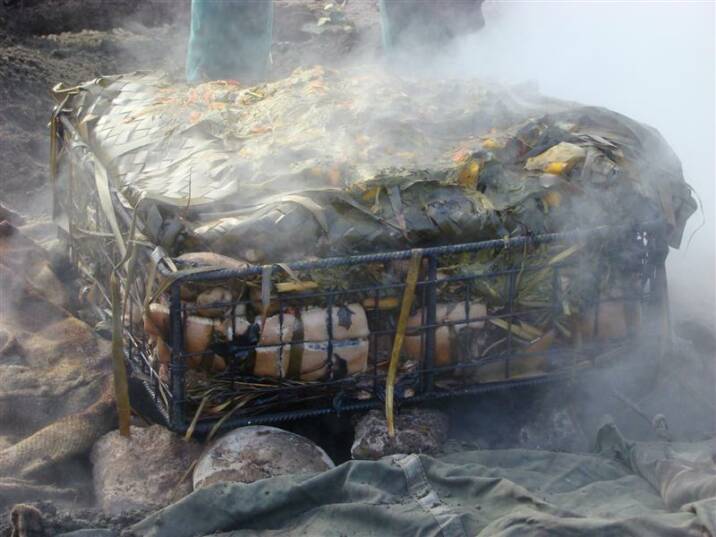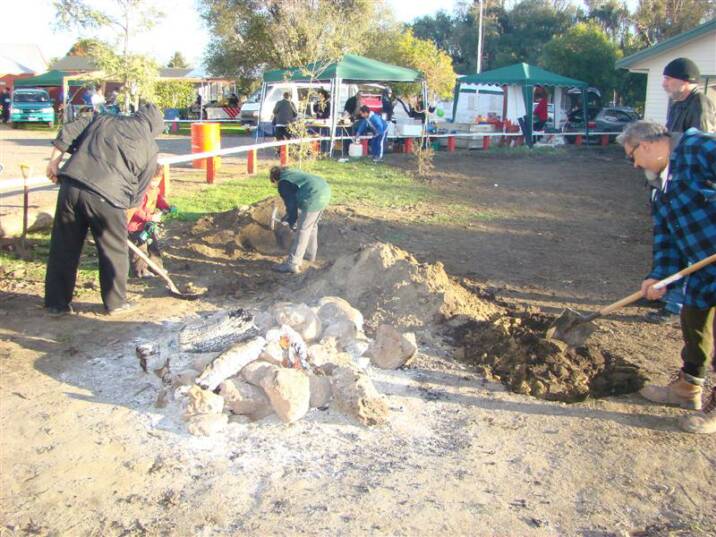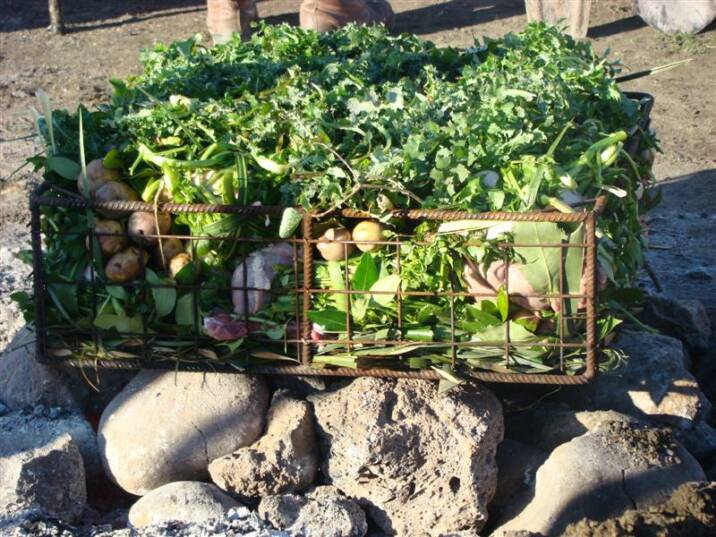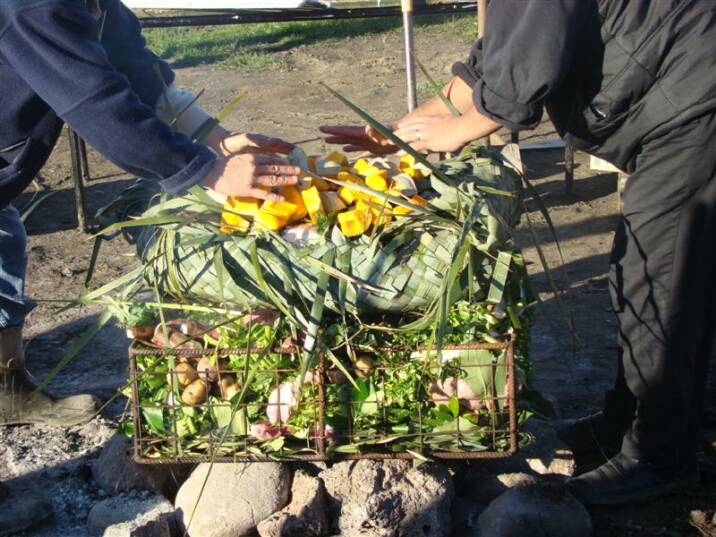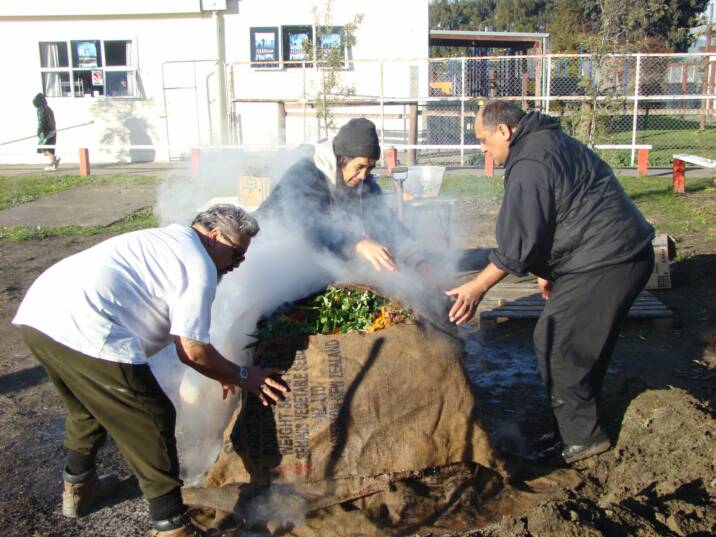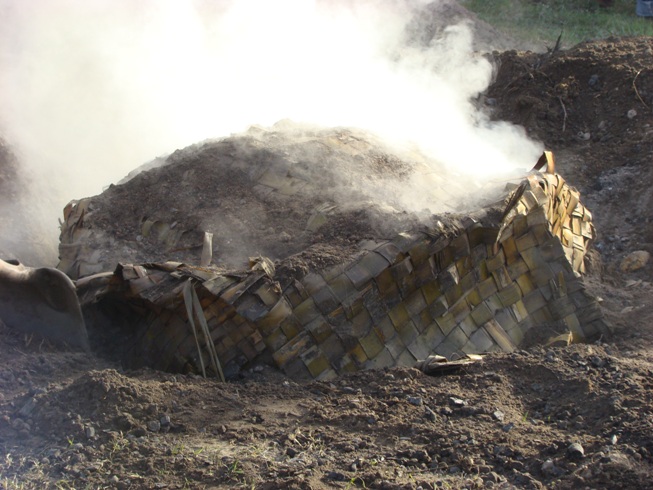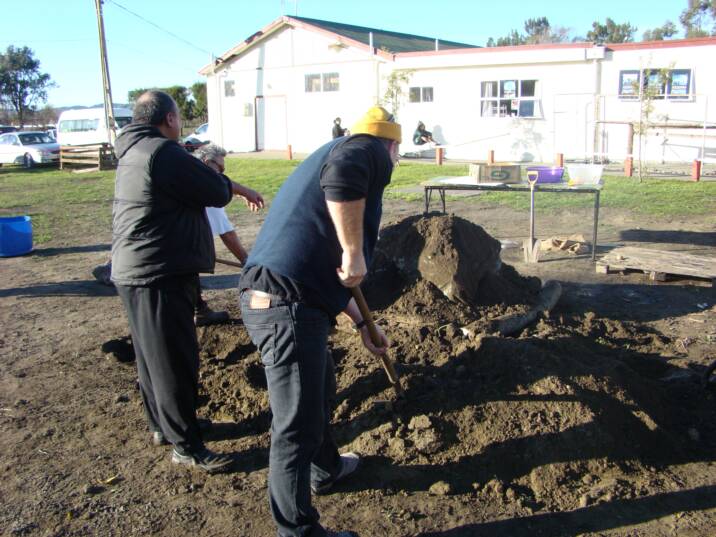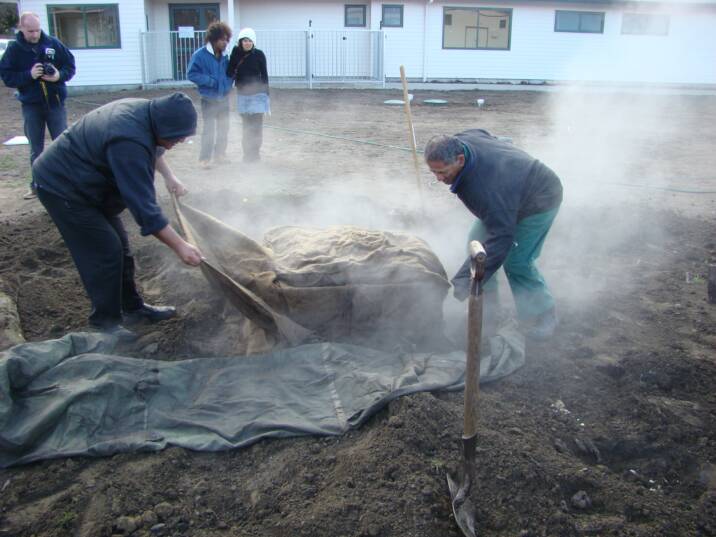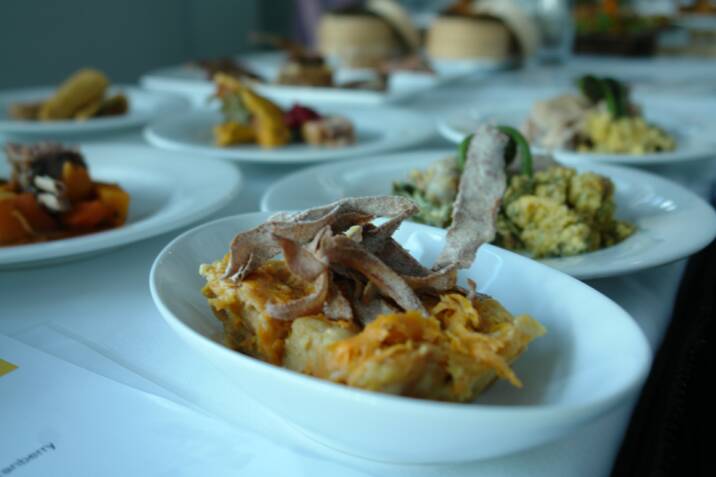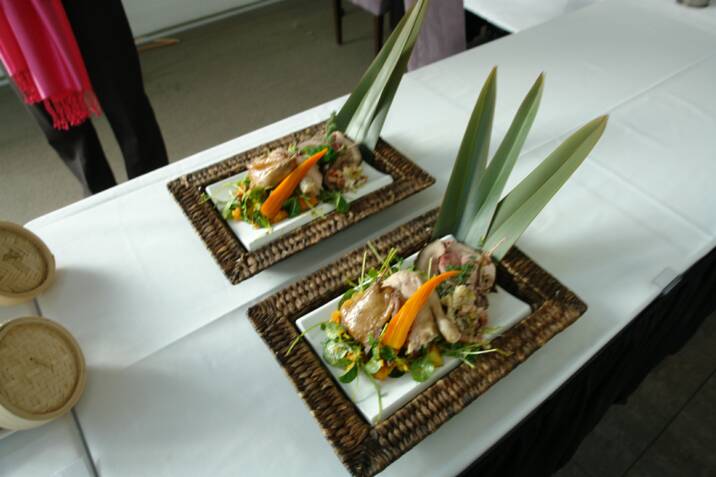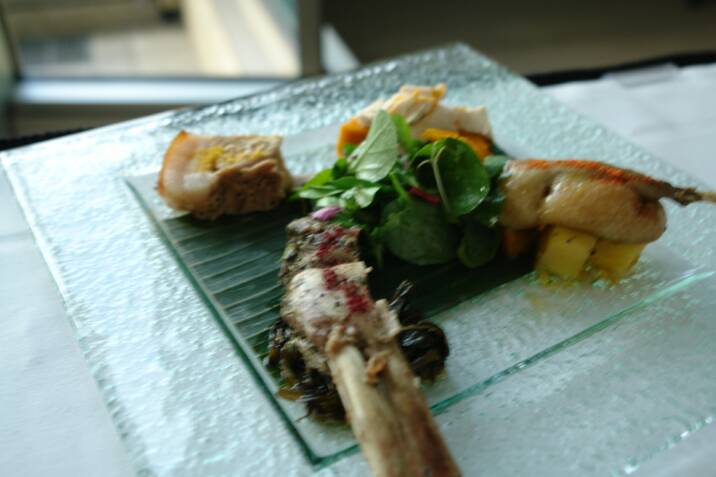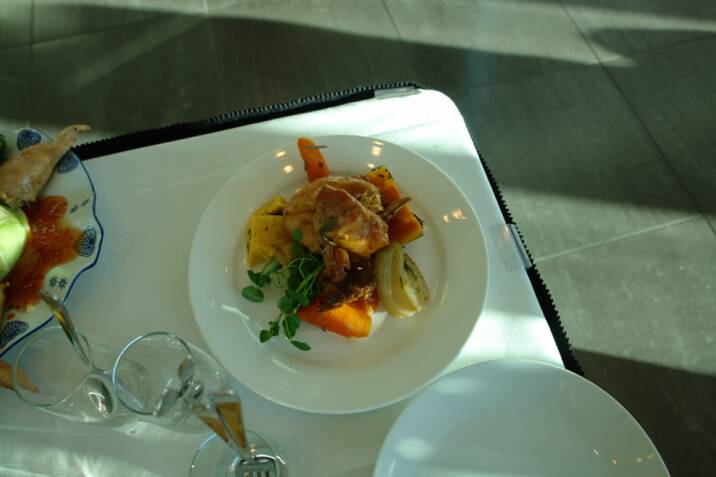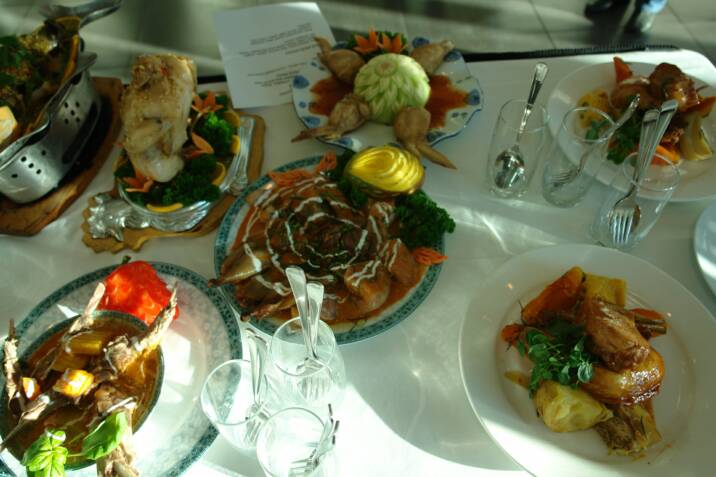THE NEW ZEALAND MAORI HANGI
FOODS, PREPARATIONS AND METHODS USED
The most widely used method of cooking by Maori Culture for over two thousand years and not forgetting our fellow Island neighbors in the Pacific who also use this method we all refer to as the Umu. Today for economical reasons, the traditional hangi cooking principals are now used primarily for special occasions. Historically the principal use of the hangi cooking method goes back further. It was spoken and believed that our ancestors heated some stones, meats were placed on top, that was topped with vegetation and left to cook. Later through trial and error or by accident modifications to this process helped identify the best cooking method. That method has not changed since and for Maori this process is identified in our prayers, songs, dance and story telling's that go back centuries. We have since discovered that this method of cooking was and still is used in Chile, the Balkans, and certain parts of North Africa and the Middle East.
During the time line of Maori occupation of Aotearoa Iwi Hui or gatherings involved participation by the entire whanau, hapu, Iwi or Runanga population on the Marae. Some populations numbering several hundred, the larger Marae. or Iwi numbered several thousand. Smaller family or worker whanau groups would generally live near their gardens, fishing sites, hunting grounds at times placing a Rahui or protection order over some areas because an omen predicted it, a death or to allow that particular area to recover and to protect sacred areas because of the sacredness of the place unique to locals or tangata Whenua.
Each whanau or family in the Marae was responsible for caring for their own needs within the confines of their whare units, wharepuni, wharenui or home. Whenever guests would arrive on the Marae after going through typical traditional welcoming procedures 'the karanga', senior members of the household would contribute to the catering needs of the guests of either cooked or preserved foods. This simple process was the set standard practiced in most villages or Marae throughout New Zealand's Cuisine process still practiced today in Koha
Over time Hangi Recipes were passed down generations some unchanged to this day and some best kept in the past.
Cooking was not done in the main house, but in specially built sheds called whanau or kauta, or the food was simply cooked out in the open. Food was generally eaten in the open, or in a whanau. Distinguished visitors, if sleeping in the large important meeting house, might be served with food in the house, but the food must be placed in the narrow space left in the center as you enter the door. On no account whatsoever must food be put on a sleeping place.
A quick lesson how the Hangi process is put together is as follows, this method taught to generations of would be hangi makers throughout the Pacific region. The process is the same BUT the ingredients used....now that's where each region in the Pacific differs especially for Maori.
Foods are prepared in three sections, meats (pork, beef, lamb, shell fish, fish) - kumara, potato and vegetables and puddings (yes that's right everything goes in together)
- Stones are heated to the white hot stage
- Use only untreated wood. Manuka is favored most in New Zealand amongst Maori
- Food is placed on top meats first (after which the entire Hangi is watered slightly to cause steam to form)
- The food is then covered with flax matting or leaves or both then buried under dirt
- The food is steam cooked under pressure from the leaves and soil
- The Hangi must cook or simmer for at least three hours (standard time frame in New Zealand)
- Food is removed from oven and served
The initial step to "put the down a hangi" involves digging a pit in the ground, heating stones with a large fire, placing foods on top of the stones, and covering with a cover like Hessian bags, sheets, flax mats and then covering everything with leaves or dirt for cooking for three hours before uncovering (or lifting) the hangi. There are many variations and a hangi produces rich, succulent food with a flavor quite unlike anything else.
As mentioned earlier the Hāngi is an ancient New Zealand method of cooking food using super heated rocks buried in the ground in a pit oven. Modernized Hangi methods are still used today and are often saved for special occasions due to the large amount of time and preparatory work involved.
Prior to colonization and the introduction of metals and wire, food was laid out on clean sticks, bark, large leaves and other vegetation to minimize direct contact with the super hot rocks and reduce burning. Some Iwi used carved bowls called "Kono" to cook foods by placing hot rocks into a liquid base that heat up the liquid and so cook foods in that manner. The types of foods cooked were vegetable leaves like the puha, kokihi, kohetake, fish, and birds. This method of cooking or heating foods however was not favored in terms of cooking a meal BUT was favored by Tohunga for heating leaves and bark for medicinal and spiritual purposes. The introduction of the cooking vessel we call a POT changed everything. It also meant the end of the daily use on the Hangi cooking method.
Some times during the making of the Hangi, sticks were stacked or placed across the rim of the Hangi to to prevent crushing from the weight of the earth on top. A process or term we call rakau korehina. These days, there are many different Hangi methods used. Wire baskets became widely used in the early 19th century with sacking and cloth replacing leaves and bark as the covering of choice.
Recently, gas heated stainless steel "Hangi Machines" have attempted to replicate the style of cooking without need for a fire, rocks and a pit. There are other methods used as well like converted beer kegs, 44 gallon drums, milk tanks from old cowsheds, old ovens, but now an underlying issue as to what constitutes a "real" or authentic Hangi is posed.
Hangi cooking gives food a unique flavor that Kiwis appreciate. There are several components that can affect flavors of the food for example by the type of earth used, amount of heat in the rocks, quantity of food and portion size, type of food and food placement, and the leaves used. Adding water at the start creates steam instantly. This in turn is quickly covered with sacking and dirt and is buried. The whole pit process almost resembles a low pressure cooker with a measured pressure reading in excess of 4 PSI.
Sometimes foods were cooked directly on dry heat from white hot rocks creating an oven roasting effect with temperatures at times reaching 300°C. A process used for cooking large pieces of meat and shell fish like Paua. The stones are heated white hot, the meats seared on top, removed, the stones covered with leaves of the Karamuramu, Kawakawa, or similar, meats were placed on top and they in turn were covered with vegetable greens like Rourouriki and Kohetake, on top of these the kumara and finally covered with a whariki (mat made for cooking) and buried.
Fat and juices dripping from the meats and foods above fall onto the hot rocks below burning and causing steam which sets the key appearance, aroma and flavors for the Hangi outcome. The skills and knowledge preparing and cooking a Hangi have developed and improved over time to heating the stones, burying the hangi to opening the hangi to serving the food handed down generation after generation. To "lay a Hangi" or "put down a Hangi" involves digging a pit in the ground, heating stones in the pit with a large fire, placing wire baskets of food on top of the stones, and covering everything with earth for Three hours before uncovering (or lifting) the Hangi. Depending what is being cooked it is also OK the let a Hangi cook overnight. A typical Hangi setup usually details the following process
Digging the Pit
You dig the Hangi pit according to the size of the basket you are laying or the number of people you are catering for. Super heated stones are used as the cooking tool although alternative metals can be used. Wire baskets are used to hold the food, as demonstrated in the following photos. Traditionally it is the men Ko na ira Tane who put the Hangi's down as Wahine (women) aren't allowed to take part in this part of the preparation. The men and the woman work together in preparing the food for the Hangi.
The Stones and Heating them
Hāngi stones used must be able to withstand high heat and the favored ones are the volcanic stones because they do not explode or chip during cheating. There is a testing method used to locate good rocks for the Hangi that If striking the stone with a hammer produces a ringing noise rather than a thud, then the stone is good to use in the Hangi. If Volcanic stones are not available then those taken from the middle of a stream or river is preferred. A sort of tempering process that only mother nature can do. Large stones are better as they hold the heat needed. Bricks are sometimes used if no appropriate natural stone can be found.but be careful here because they loose heat quicker than stone. The stones are heated in a large wood fire. Building a lattice of strong wood beams that can support the stones until they fall in is important, as stones buried in ash (as compared to hot coals) are losing heat, not gaining it. The total burn time depends on the size of the Hangi being laid, but is usually between one and a half hours and two and a half hours.
The Food
Traditional and contemporary Hangi food can be found on our recipe page but pork, mutton or lamb, and chicken, with generous portions of root vegetables such as kumara (sweet potato), pumpkin, carrot, potato, onions and cabbage are the normal foods used throughout New Zealand. Special care and preparation goes into producing the food needed besides root vegetables like potatoes, kumara, taro, yams, cassava, tapioca, taro leaves, cabbage leaves and many other variations
The addition of herbs and spices to the Hangi makes no difference to the flavor because everything is flavored the same although attempts at separating flavors is being studied. In terms of flavoring certain foods, our people would do this by cooking certain foods alone in serrate Hangi's. For example the cooking oh Paua was done by itself. The adding of herbs such as rosemary, garlic into stuffing's for chicken adds amazing and exciting flavors. The food is placed in muslin lined wire baskets. If muslin is not available, clean white cotton bed sheets are fine. This cloth is soaked in water to prevent burning and provide water for steaming the food.
Laying the Hāngi
This whole step is done as quickly as possible to prevent heat loss from the stones. When the fire has burned down the ash and coals must be removed or they dominate the flavor, but leaving a few coals gives a smoky flavor which some people prefer. Spraying the rocks very briefly with water produces a rush of steam that removes any loose ash.
Hessian cloth sacks, soaked in water are laid atop the food and helps to provide water for steam. The food-filled baskets are then placed atop the Hessian sacking, and covered with more wet Hessian sacks to keep the dirt away. The whole arrangement is then rapidly covered with loose soil from the original pit to seal in heat and steam.
Once the Hangi is buried, any escaping steam is sealed by applying more soil. The cooking time allotted is is usually three to four hours, depending on the quantity of food being cooked. And when it is done and cooked, the aroma's, scents, and flavors hit you hard and the rest is just amazing
The applications of this style of cooking can be used anywhere and would be appreciated by those who eat Hangi for the first time. It is also one of the safest modes of cooking because everything gets cooked thoroughly and cleanly. Here is another link that takes you through this process presented by the New Zealand Food Safety Authority. NZFSA.
Now what of the Hangi from our Pacific Island neighbors. See some of their traditional hangi methods. One whanau shared his amazing version using the kerosene tin transformed into a hangi for one person, an idea he created to feed himself when on the road or working in the field tending to his 'dalo' patch, the idea was laughable BUT hey it worked every time and it was beautiful to see and enjoy the food, cooking time 60 minutes......
Kia ora, you are the visitor to this page
Copyright © 2000 Epuro Hands International Limited
Copyright © 2005
All content on this site, remain the property of Epuro Hands International Limited and are protected by New Zealand and International copyright laws.
No part of this website may be reproduced without the expressed, written permission of http://www.epurohands.com
The Cooking Oven is Prepared
Hangi well cooked ready to serve
The Food is Prepared
The Basket is Prepared
More Food is Added
The Stones are Super Heated
The Wood & Stones Prepared
Water splashed over the hangi to cause steam & covered
Steam builds up fast
Critical the hangi is swiftly buried
Hangi is left to cook 3-4 hours
4 Hours later the dirt is removed
Then the Sacking is removed
Then the Hangi is exposed
The Hangi
The preparation journey of the Hangi from start to finish with many hands that make light work and the essense of the hangi experience one always remembers for a long time
Hangi served ready for banquet
Hangi served to impress
Hangi served platter style
Hangi with unique European flavours (meats marinated in beer before going into the hangi)
Hangi Served restaurant style
Hangi with an Asian twist (curried)
The Hangi
Long standing traditional way of cooking food in a traditional pacific ground oven.
Neville Rangi-Tane Pettersson who a few years ago wanted to put down a Hangi for a party he was hosting - had absolutely no idea how to do it - frustrated and so with the help of a few whanau created his own website - Now we have our own official New Zealand Hangi Website - click here and sign up to be a member


